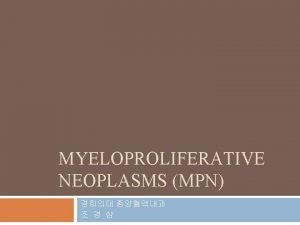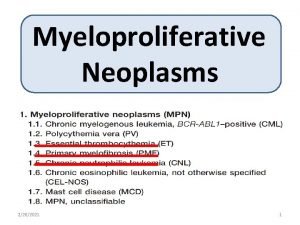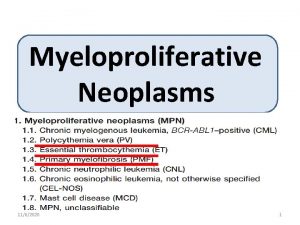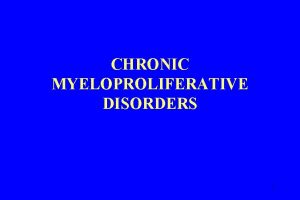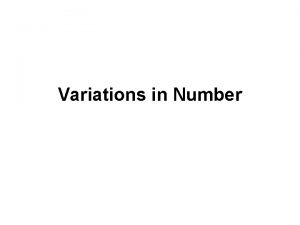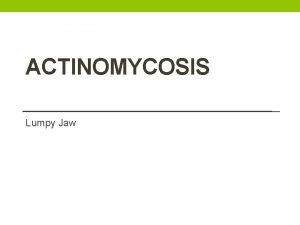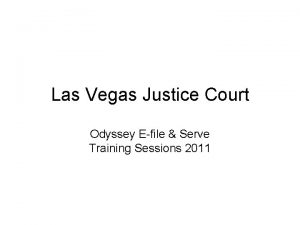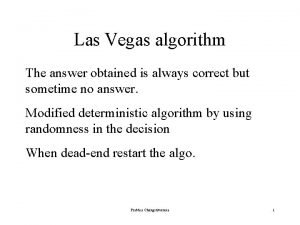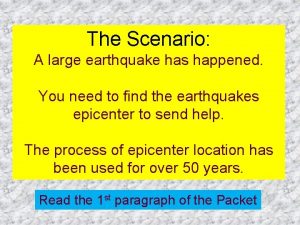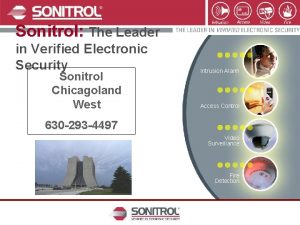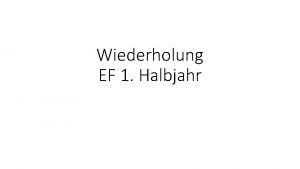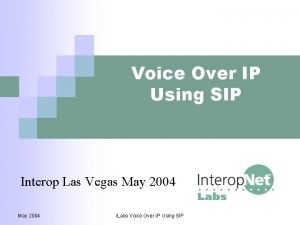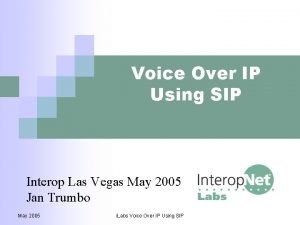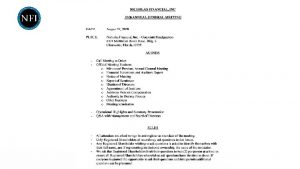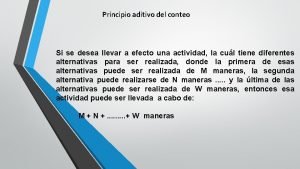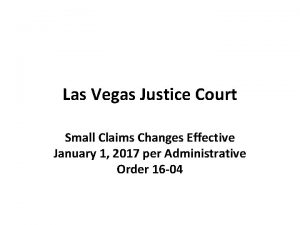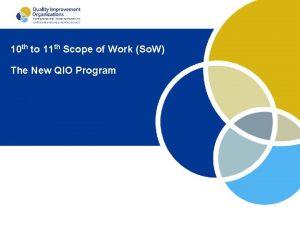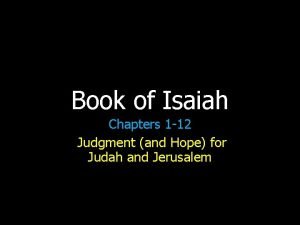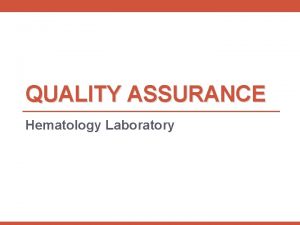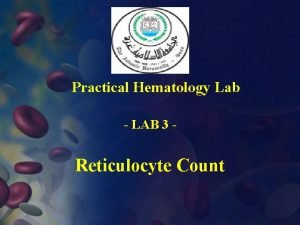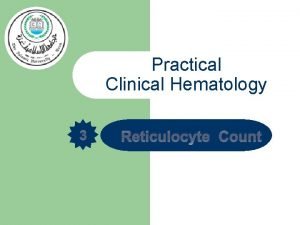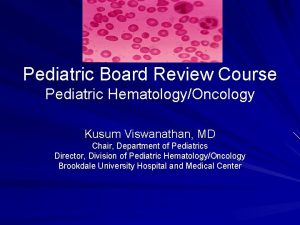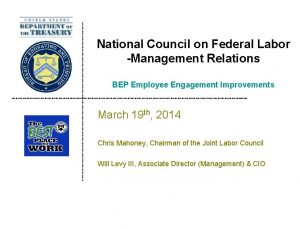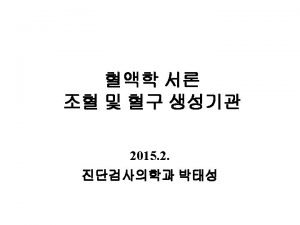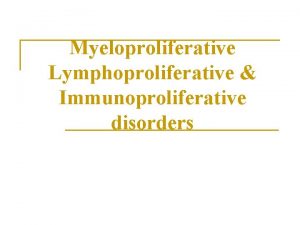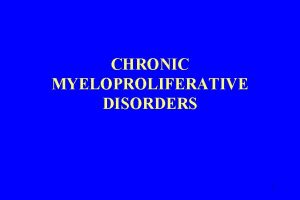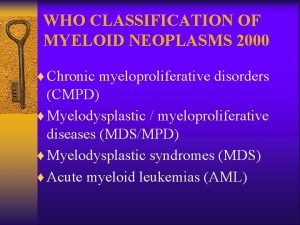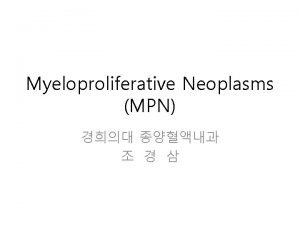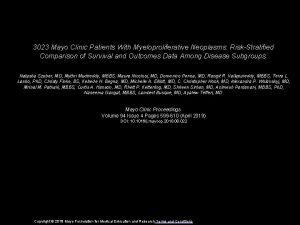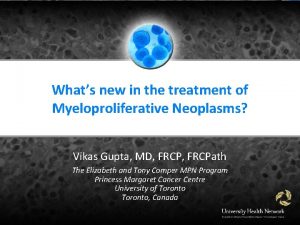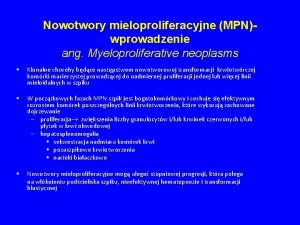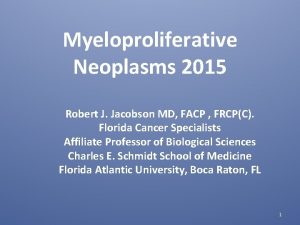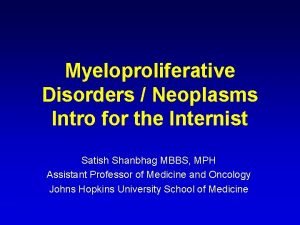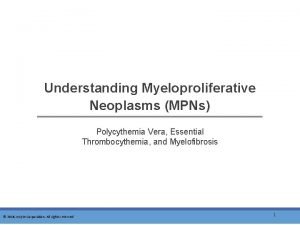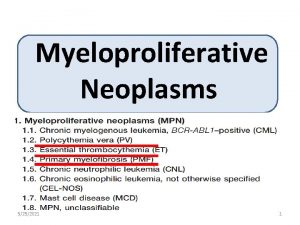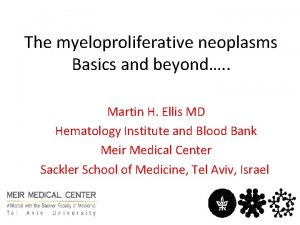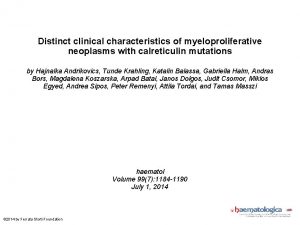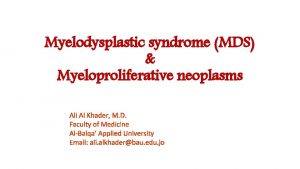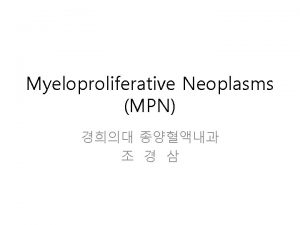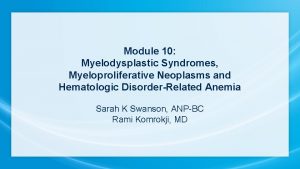Arizona USA Myeloproliferative Neoplasms Hematology Highlights Las Vegas














































- Slides: 46

Arizona, USA Myeloproliferative Neoplasms Hematology Highlights Las Vegas, NV, USA – February 27, 2014 Ruben A. Mesa, MD Professor & Chairman, Division of Hematology & Medical Oncology Deputy Director, Mayo Clinic Cancer Center Mayo Clinic – Arizona, USA © 2011 MFMER | 3133089 -1

Myeloproliferative Neoplasms Hematology Highlights 2014 • Burden and Biology of MPNs • JAK 2 Inhibition in 2014 • JAK 2 Inhibition and beyond

The Natural History of MPNs Diagnosis WHO 2008 Essential Thrombocythemia Polycythemia Vera Early/ Pre-fibrotic Primary Myelofibrosis Classic Primary MF Post ET/PV MF MPN Blast Phase

© 2011 MFMER | 3133089 -4

Calreticulin (CALR) Within ER - chaperone ensuring quality control of glycoprotein folding - calcium homeostasis Outside ER - found in cytoplasmic, cell surface and extracellular compartments - roles in: proliferation apoptosis phagocytosis immunogenic cell death

CALR mutations in JAK 2 negative ET and MF

Burden of ET/PV Macrovascular Risk Et & PV Associated Symptoms Microvascular Symptoms MF MPN Associated Associate Symptoms d Splenomegaly Symptom s Anemia/ Cytopenis Burden of Myelofibrosis

Myelofibrosis and Cytopenias (N=364) Tx Dep 24% Hb <10 g/d. L -Tx Dep 18% N. B. • Varying times • NL Hg • Men 13. 5 g/d. L • Women 12 g/d. L Hb - Normal 25% Hb 10 g/d. L - PLT = 50 -99 Normal 11% 33% WBC < Normal 10% PLT < 50 9% WBC ≥ Normal 90% PLT = 100 -149 10% PLT > 150 70% Emanuel et. al. JCO 2012 © 2011 MFMER | 3133089 -8

Myelofibrosis and Splenomegaly 11% Splenomegaly Not Enlarged Cervantes et. al. Blood 2009 (N=1054 PMF) 89% Splenomegaly 36% Not Enlarged 64% Emanuel et. al. JCO 2012 (N=329 MF) Why does Splenomegaly Matter in MF? • Mechanical discomfort • Pain • Possible splenic infarction • Early satiety adding to cachexia • Splenic sequestration and exacerbation of cytopenias • May delay engraftment in setting of allogeneic stem cell transplant © 2011 MFMER | 3133089 -9

MPN Symptom Burden by Quartiles 1858 MPN-SAF Respondents Q 1 TSS <8 Q 2 TSS 8 -17 Parameter Age Q 3 TSS 18 - 31 Q 4 TSS >32 P value of Comparison 0. 24 Gender F>M <0. 001 MPN Diagnosis <0. 001 Subtype of MF 0. 86 IPSET (ET Risk) 0. 18 PV Risk (PV) 0. 30 DIPSS (MF Risk) <0. 001 Quartile 1 (Q 1): 0 -24% Quartile 2 (Q 2): 25 -49% Quartile 3 (Q 3): 50 -74% Quartile 4 (Q 4): 75 -100% Percentile MPN-SAF TSS

ET (N=775) Q 1 – 30% Q 2 – 26% Q 3 – 24% Q 4 – 20% PV (N=654) Q 1 – 25% Q 2 – 23% Q 3 – 26% Q 4 – 26% MF (N=423) Q 1 – 17% Q 2 – 21% Q 3 – 26% Q 4 – 36%

New Response Criteria for MPNs ET 2 PV 2 MF 1 Complete response � � � Partial response � � � Clinical improvement � Stable disease � No response � � Relapse Other responses Molecular � Cytogenetic and molecular 1. Tefferi A et al. Blood. 2013; 122: 1395 -1398. 2. Barosi G et al. Blood. 2013; 121: 4778 -4781.

New Response Criteria for MF: Complete Response 1 Required criteria: for all response categories, benefit must last for ≥ 12 wks to qualify as a response Bone marrow: Age-adjusted normocellularity; <5% blasts; ≤Grade 1 MF; and Peripheral blood: Hemoglobin ≥ 100 g/L and <UNL; Neutrophils ≥ 1 x 109/L and <UNL; Platelets ≥ 100 x 109/L and <UNL; <2% immature myeloid cells; and Clinical: Resolution of disease symptoms Spleen and liver not palpable No evidence of EMH: extramedullary hematopoiesis 1. Tefferi A et al. Blood. 2013; 122: 1395 -1398.

New Response Criteria for MF: Other Categories 1 Clinical improvement Anemia response Achievement of anemia, spleen, or symptoms response without progressive disease or increase in severity of anemia, thrombocytopenia, or neutropenia Transfusion-independent pts: a ≥ 20 g/L increase in Hb level Transfusion-dependent pts: becoming transfusion independent Baseline splenomegaly that is palpable at 5 -10 cm, below the LCM, becomes not palpable, OR Spleen response Baseline splenomegaly that is palpable at >10 cm, below the LCM, decreases by ≥ 50% Baseline splenomegaly that is palpable at <5 cm, below the LCM, is not eligible for spleen response Symptoms response A ≥ 50% reduction in the MPN-SAF TSS CI: clinical improvement; LCM: left costal margin. 1. Tefferi A et al. Blood. 2013; 122: 1395 -1398.

Myeloproliferative Neoplasms Hematology Highlights 2014 • Burden and Biology of MPNs • JAK 2 Inhibition in 2014 • JAK 2 Inhibition and beyond

JAK Inhibitors and Status of Development Myelofibrosis as lead indications Ruxolitinib (FDA Approved) * Pacritinib (SB 1518) Momelotinib (CYT 387) * LY 2784544 * BMS-911543 NS-018 INCB 039110 (JAK 1) Fedratininb (SAR 302503) * No Longer in Development For MPNs CEP 701 XL 019 * Now Testing AZD 1280 in PV 0 1 2 3 4 © 2011 MFMER | 3133089 -16

Patient Disposition – 3 Year FU Comfort I Placebo Ruxolitinib (n = 155) Placebo (n = 151) Placebo Ruxolitinib (n=111) 145 37 105 77 (49. 7) 0 57 (51. 4) Median exposure, weeks Still on treatment, n (%) Crossed over, n (%) Discontinued, n (%) 111 (73. 5) 78 (50. 3) 40 (26. 5) 54 (48. 6) Death 15 (19. 2) 7 (17. 5) 11 (20. 4) Adverse event 15 (19. 2) 9 (22. 5) 8 (14. 8) Consent withdrawn 12 (15. 4) 7 (17. 5) 11 (20. 4) Disease progression 18 (23. 1) 13 (32. 5) 15 (27. 8) Primary reasons for discontinuation, n (%)* • All patients originally randomized to placebo crossed over or discontinued within 3 months of the primary analysis • Median time to crossover: 41. 1 weeks ASH 2013 * Percentages are calculated based on the number of patients who discontinued within the respective treatment group. 17

ASH 2013 Mean Daily Dose of Ruxolitinib Over Time Mean Daily Dose (mg, BID) ± SEM 25 20 mg BID starting dose 15 mg BID starting dose 20 15 10 5 0 0 8 16 24 32 40 48 56 64 72 80 88 96 104 112 120 128 136 144 Weeks Number of patients 20 mg BID 100 98 93 77 73 69 62 15 mg BID 49 35 33 30 26 20 55 • Approximately 70% of patients had dose adjustments during the first 12 weeks of therapy • By week 24, patients originally randomized to RUX 15 mg BID and 20 mg BID were titrated to a mean dose of ~10 mg BID and 15 -20 mg BID, respectively 18

ASH 2013 Percentage Change in Spleen Size • Mean reductions in spleen volume and palpable spleen length with ruxolitinib were stable over time Spleen Volume Ruxolitinib Spleen Length Placebo Ruxolitinib 10 0 n = 148 139 120 107 100 84 73 132 107 35 -10 -20 -30 -40 -50 -60 12 24 48 72 96 120 144 Weeks 12 24 48 Mean Percentage Change from Baseline 10 Placebo 0 n = 153 152 150 141 130 110 102 90 79 147 141 136 109 47 -10 -20 -30 -40 -50 -60 4 8 12 24 48 72 96 120 144 Weeks 4 8 12 24 48 19

ASH 2013 Improvements in EORTC QLQ-C 30 Over Time 20 15 10 5 0 -5 -10 -15 0 12 24 36 48 60 72 84 Weeks 0 -5 -10 -15 -20 -25 -30 -35 0 Mean Change From Baseline 0 5 12 24 96 108 120 132 144 36 48 60 72 84 96 108 120 132 144 Weeks RUX PBO Arrows indicate improvement Role Functioning 25 20 15 10 5 0 -5 -10 -15 -20 -25 10 96 108 120 132 144 Weeks Mean Change From Baseline Fatigue Mean Change From Baseline Global Health Status/Qo. L Physical Functioning 15 10 5 0 -5 -10 0 12 24 36 48 60 72 84 Weeks 96 108 120 132 144 20

ASH 2013 Overall Survival • Overall survival favored patients originally randomized to ruxolitinib compared with patients originally randomized to placebo 1. 0 Randomized to Ruxolitinib 0. 8 Probability * Randomized to Placebo Ruxolitinib 0. 6 HR=0. 69 (95% CI: 0. 46, 1. 03); P=0. 067 0. 4 No. of deaths: Ruxolitinib=42; Placebo=54 Median follow-up: 149 weeks 0. 2 Percent of at-risk placebo who crossed over or discontinued 0 0 4 13 8 16 24 32 40 48 56 64 72 80 88 96 104 112 120 128 136 144 152 160 168 176 Number of patients at risk 22 35 54 73 88 97 99 100 100 100 100 Weeks Ruxolitinib 155 153 148 145 143 137 131 125 124 122 115 112 111 108 106 101 84 45 19 1 0 Placebo 154 153 149 144 134 129 114 107 105 100 95 38 28 8 0 92 88 85 82 79 68 *By week 80, all patients originally randomized to placebo discontinued or crossed over to ruxolitinib therapy 21

Overall Survival: Rank-Preserving Structural Failure Time (RPSFT) Analysis ASH 2013 1. 0 Probability 0. 8 Ruxolitinib 0. 6 Placebo Ruxolitinib 0. 4 Placebo-RPSFT 0. 2 HR=0. 36 (95% CI: 0. 204, 1. 035) 0 0 8 16 24 32 40 48 56 64 72 80 88 96 104 112 120 128 136 144 152 160 168 176 Weeks • RPSFT is a recognized method to estimate HR after adjusting for crossover 1 -5 • Hazard ratio of 0. 36 is consistent with the hypothesis that ITT analysis underestimates the survival benefit of ruxolitinib relative to “true placebo” (1) Robins J, Tsiatis A. Commun Stat Theory Methods. 1991; 20: 2609 -31; (2) Demetri GD, et al. Clin Cancer Res. 2012; 18: 3170 -79; (3) National Institute for Health and Care Excellence (NICE). NICE technology appraisal guidance 179. http: //guidance. nice. org. uk/TA 179. Issued September 23, 2009; (4) Sternberg CN, et al. Eur J Cancer. 2013; 49: 1287 -96; (5) National Institute for Health and Care Excellence (NICE). NICE technology appraisal guidance 215. http: //guidance. nice. org. uk/TA 215/Guidance/pdf/English. Issued February 2011. 22

Mean Platelet Count and Hemoglobin Level Over Time ASH 2013 Platelet Count Ruxolitinib 115 Placebo Mean Hemoglobin (g/L) Mean Platelets (x 109/L) 370 Hemoglobin 320 270 220 170 120 0 12 24 36 48 60 72 84 96 108 120 132 144 Ruxolitinib 110 105 100 95 90 85 0 12 24 36 48 Weeks 60 72 84 96 108 120 132 144 Weeks Number of patients RUX 155 144 143 136 124 112 110 107 104 100 PBO 151 128 112 Placebo 82 37 94 88 79 155 143 136 124 113 110 107 104 100 151 132 113 83 94 88 79 37 23

Incidence of New Onset All Grade Non-hematologic Adverse Events Regardless of Causality ASH 2013 Incidence (%) Fatigue Diarrhea Ecchymosis Peripheral edema Dyspnea Dizziness Pain in extremity Headache Nausea Constipation Abdominal pain Insomnia Vomiting Pyrexia Cough Arthralgia Upper respiratory tract infection 0–<12 months (n=155) 29. 0 27. 8 21. 2 21. 3 19. 2 18. 1 18. 0 16. 6 14. 5 13. 8 13. 7 13. 5 13. 1 11. 8 7. 7 Ruxolitinib 12–<24 months 24–<36 months (n=130) (n=103) 15. 2 15. 3 6. 7 10. 8 10. 4 5. 7 8. 4 12. 6 10. 2 2. 9 10. 4 3. 0 6. 2 4. 2 5. 1 2. 7 6. 8 5. 1 8. 6 10. 1 5. 7 3. 6 5. 7 3. 7 2. 8 2. 4 7. 3 8. 5 13. 3 4. 0 5. 8 6. 6 11. 1 4. 0 ≥ 36 months (n=82) 7. 7 3. 9 0 0 3. 3 3. 5 3. 3 0 5. 9 9. 0 0 0 5. 5 2. 9 6. 0 6. 3 3. 2 • There was no change in the rate, distribution, or severity of nonhematologic adverse events in the ruxolitinib group with longer-term treatment; most nonhematologic adverse events were grade 1 or 2 Percentage of patients for each event was based on the effective sample size of the time interval (number of patients at risk at the beginning of the interval minus half of the censored patients during the time interval ). Adverse event is included if the incidence was >10% at any yearly interval. 24

Incidence of New Onset Grade 3 or 4 Non-hematologic Adverse Events Regardless of Causality ASH 2013 Ruxolitinib Incidence (%) 0–<12 months (n=155) 12–<24 months (n=130) 24–<36 months (n=103) ≥ 36 months (n=82) Fatigue 6. 2 0. 9 3. 3 0 Pneumonia 5. 6 3. 5 0 Abdominal pain 4. 2 0 3. 2 0 Arthralgia 2. 1 0 0 0 Diarrhea 2. 1 0 0 0 Dyspnea 2. 1 0. 9 2. 2 2. 5 Pain in extremity 2. 1 0 1. 1 0 Hyperuricemia 1. 4 0. 9 0 2. 5 Fall 1. 4 0. 9 0 0 GI hemorrhage 1. 4 0. 9 0 0 Septic shock 1. 4 0 0 0 Muscular weakness 1. 4 0 1. 1 0 Hypoxia 1. 4 0 2. 2 0 Sepsis 0. 7 1. 7 2. 2 0 Epistaxis 0. 7 1. 7 0 0 Renal failure acute 0. 7 0. 9 2. 2 2. 4 Abdominal pain upper 0. 7 0 2. 2 0 Myocardial infarction 0 0. 9 0 4. 8 Percentage of patients for each event was based on the effective sample size of the time interval (number of patients at risk at the beginning of the interval minus half of the censored patients during the time interval ). Adverse event is included if the incidence was ≥ 2 patients at any yearly interval. 25

BM Morphology in a Ruxolitinib-Treated Patient: A Case Demonstrating Improvement on Ruxolitinib ASH 2013 Baseline Biopsy Grade 3 Kvasnicka HM, et al. ASCO. 2013 (abstr 7030). 24 Mo Post Ruxolitinib Grade 2 48 Mo Post Ruxolitinib Grade 0 Permission to use images from Kvasnicka, HM 26

Dynamics of BM Changes Following Ruxolitinib Treatment at 48 Mo Kvasnicka, et al. ASH 2013. Abstract 4055. ASH 2013 27

Yes No Occasional Not Reported Yet JAK 1 & 2 Inhibitors in MPNs – Efficacy Summary – As of ASH 2013 Myelofibrosis Polycythemia Vera Ongoing Trials Essential Thrombocythemia Spleen Const. Sympt. Anemia Survival Counts Const. Sympt. Vasc Events Ruxolitinib - Approved P III P II P II SAR 302503 – PH III JAKARTA (HOLD) P III Pacritinib. PIII Ongoing (Persist MF) P II CYT 387 P II LY 2784544 P I BMS-911543 PH II INCB 039110 (JAK 1 Alone) P I CEP 701 P II NS-018 PI P II © 2011 MFMER | 3133089 -28

JAK 1 & 2 Inhibitors in MPN – Toxicity ASH 2013 Hematological Toxicities Anemia ANC Gastrointestinal/ Renal Toxicities Nausea PLT Diarrhea LFTs Or CR Ruxolitinib Approved 23% 7% 11% SAR 302503 – PIII Ongoing (MF) 41% 6% 11% 0% 5% 1% Pacritinib. PIII Ongoing (MF) 6% 0% 18% 6% CYT 387 PII Ongoing (MF) 10% INCB 039110 (JAK 1) – PI/II MF 28% BMS 911543 3% LY 2784544 3% 10% Lipase Neurological Toxicities Headache 2% Dizzy Neuro. P/ Parathia 0. 6% W. E. % ? 2% 20% 0% 27% 10% 0% 0% 3% 8% Renal 1% Toxicity Color – Represents All Grades ( Grade ¾ Toxicity - Percentage in Table Above) <10% 1120% 2130% 3140% 4150% 5160% 6170% 7180% 8190% 91100% © 2011 MFMER | 3133089 -29

Myeloproliferative Neoplasms Hematology Highlights 2014 • Burden and Biology of MPNs • JAK 2 Inhibition in 2014 • JAK 2 Inhibition and beyond

Clinical Status MPNs – Plateau vs. Decline ET – Possible Plateau Asymptomatic Thrombocytosis No Vascular Events PV – Possible Plateau 2 Symptomatic Erythrocytosis MF on Successful JAK 2 Rx ET – Possible Plateau 2 No Vascular Events Improving Weight Symptomatic Thrombocytosis Decreased Spleen Sinus Venous Thrombosis Improved Survival Post PV MF 6 Months worsening Fatigue 10 kg weight loss Massive spleen Time © 2011 MFMER | 3133089 -31

Clinical Status MPNs – Cumulative Benefits Ruxolitinib Improved Survival Improved Spleen Burden Improved Symptom Burden Time © 2011 MFMER | 3133089 -32

Clinical Status MPNs – Cumulative Benefits Single Agent Trials JAK 2 Inhibitors Compared to Ruxo ? Other Benefit -Less cytopenias -Improved activity STUDY (JAK 2/FLT 3 Inhibitor) Pacritinib (SB 1518) (PH III vs. BAT) NCT 01773187 Improved Survival STUDY (JAK 2/JAK 1 Inhibitor) Momelotinib (CYT 387) (PH III vs. Ruxo) NCT 001969838 Improved Spleen Burden STUDY (JAK 2/FLT 3 Inhibitor) NS-018 (PH I/II) NCT 01423851 Improved Symptom Burden STUDY (JAK 2 Inhibitor – Also ET and PV) LY 2784544 (PH I/II) NCT 01520220 Time © 2011 MFMER | 3133089 -33

Clinical Status MPNs – Cumulative Benefits Ruxolitinib + drug X for Anemia STUDY COMBINATION (JAK 2 PLUS Androgen) Ruxolitinib Plus Danazol Mayo Clinic (AZ) and Mt. Sinai Trial: NCT 01732445 Improved Anemia Burden Improved Survival Improved Spleen Burden Improved Symptom Burden STUDY COMBINATION(JAK 2 PLUS Hypomethylation) Ruxolitinib Plus Azacitidine MDACC Trial: NCT 01787487 STUDY COMBINATION (JAK 2 PLUS IMID) Ruxolitinib Plus Lenalidomide NCT 01375140 STUDY COMBINATION (JAK 2 PLUS IMID) Ruxolitinib Plus Pomalidomide Germany (ULM): NCT 01644110 Time © 2011 MFMER | 3133089 -34

Clinical Status MPNs – Cumulative Benefits Ruxolitinib + drug X for Deeper Marrow Changes Impact STUDY COMBINATION (JAK 2 PLUS HDAC Inhibitors) Ruxolitinib Plus Panobinostat Mt. Sinai Trial: NCT 01693601 UK Trial: NCT 01433445 Improved Marrow Dysfunction Improved Survival Improved Spleen Burden Improved Symptom Burden STUDY COMBINATION (JAK 2 PLUS LOXL 2 Inhibitors) Ruxolitinib Plus GS-6624 NCT 01369498 STUDY COMBINATION (JAK 2 PLUS rh. PTX-2 (Anti -fibrosing)) Ruxolitinib Plus PRM -151 Opening Soon STUDY COMBINATION (JAK 2 PLUS PI 3 Kinase Inhibitor) Ruxolitinib Plus BKM 120 NCT 01730248 STUDY COMBINATION (JAK 2 PLUS Hedgehog Inhibitor) Ruxolitinib Plus LDE 225 NCT 01787552

Clinical Status MPNs – Cumulative Benefits Single Agent Trials Alternate Targets STUDY (Interferons) Peg Interferon α 2 b in “Early” MF Cornell Lead: NCT 01758588 ? Other Benefit -Less cytopenias -Improved activity Improved Survival Improved Spleen Burden STUDY (Activin - Act. RIIA-Ig. G 1 Fc) Sotatercept (ACE 011) MDACC: NCT 01712308 STUDY (Telomerase Inhibitor) Imetelstat (GRN 163 L) Mayo Clinic (Rochester): NCT 01731951 Improved Symptom Burden STUDY (JAK 1 Inhibitor) INCB 039110 (PH II) NCT 01633372 Time

Imetelstat: A Telomerase Inhibitor Telomerase enzyme: • Reverse transcriptase comprised of an RNA component (h. TR) and a reverse transcriptase catalytic protein subunit (h. TERT) • Binds to the 3’ strand of DNA and adds TTAGGG nucleotide repeats to offset the loss of telomeric DNA occurring with each replication cycle • Not active in somatic cells; transiently upregulated in normal hematopoietic progenitor cells to support controlled proliferation imetelstat binds to RNA template preventing maintenance of telomeres • Highly upregulated in malignant progenitor cells, enabling continued and uncontrolled proliferation Imetelstat: (h. TERT) (h. TR) • Proprietary: 13 -mer thio-phosphoramidate oligonucleotide complementary to h. TR, with covalently-bound lipid tail to increase cell permeability/tissue distribution • Long half-life in bone marrow, spleen, liver (estimated human t½ = 41 hr with doses 7. 5 – 11. 7 mg/kg); • Potent competitive inhibitor of telomerase: IC 50 = 0. 5 -10 n. M (cell-free) • Target: malignant progenitor cell proliferation – 37 – Tefferi et. al. ASH 2013

Preliminary efficacy results from Mayo Clinic investigator-sponsored trial of imetelstat in myelofibrosis Geron’s independent efficacy analysis of the first 22 MF patients enrolled in the study – 10 – Tefferi et. al. ASH 2013

Preliminary efficacy results from Mayo Clinic investigator-sponsored trial of imetelstat in myelofibrosis Geron’s independent efficacy analysis of the first 22 MF patients enrolled in the study – 10 – Tefferi et. al. ASH 2013

Change in Spleen Volume at Week 12 by Dose Cohort Median % Change in Spleen Volume* Percentage Change From Baseline at Week 12 20 5. 0 0 n=7 n=38 n=9 -9. 9 -14. 1 -20 100 mg BID 200 mg BID *Only patients with baseline and week 12 data were included. 600 mg QD INCB 039910 ASH 2013 - Mascarenhas et. al 40

Improvement in TSS at Week 12 by Dose Cohort ≥ 50% Reduction in TSS* Median % Change in TSS† 100 mg BID 200 mg BID 600 mg QD 0 50 40 34. 9 30 22. 2 20 10 n=9 n=43 Percentage Change From Baseline at Week 12 Percentage of Patients 60 n=6 n=34 n=8 -20 -28. 5 -40 -45. 8 -60 -80 -76. 8 n=10 0 -100 mg BID 200 mg BID 600 mg QD *Patients who discontinued prior to the week 12 visit were considered nonresponders; 20%-33% of patients in each group discontinued prior to week 12. †Only patients with baseline and week 12 data were included. INCB 039910 ASH 2013 - Mascarenhas et. al 41

Mean Hemoglobin Levels Over Time by Dose Cohort 13. 0 12. 5 12. 0 11. 5 11. 0 10. 5 10. 0 9. 5 9. 0 0 2 4 6 Weeks 8 10 600 mg QD 200 mg BID 12 Mean (±SEM) Hemoglobin (g/d. L) 100 mg BID 13. 0 12. 5 12. 0 11. 5 11. 0 10. 5 10. 0 9. 5 9. 0 0 4 6 Weeks 8 10 12 Patients entering the study without transfusion requirements* All Patients n, patients 100 mg BID 10 200 mg BID 45 600 mg QD 29 2 n, patients 10 45 21 9 45 10 8 41 9 8 43 10 6 39 9 6 37 9 100 mg BID 7 200 mg BID 24 600 mg QD 19 7 24 15 7 24 6 6 22 6 6 23 6 4 21 5 4 22 6 INCB 039910 ASH 2013 - Mascarenhas et. al *Receipt of 2 or more units of red blood cell product transfusions in the 12 weeks prior to day 1. 42

Clinical Status MPNs – Cumulative Benefits Difficult PV-ET STUDY (ET and PV) MPD-RC 112 Peg Inf a 2 a vs. Hydroxyurea (PH III) NCT 01259856 Improved Marrow Dysfunction Improved Survival STUDY (ET and PV) MPD-RC 111 Peg Inf a 2 a AFTER Hydroxyurea (PH III) NCT 01259856 STUDY (PV) AOP Peg Inf a 2 a vs Hydroxyurea (PH III) NCT 01230775 Improved Spleen Burden Improved Symptom Burden Improved Vascular Event Risk (? PV) STUDY COMBINATION (PV) Ruxolitinib Vs. Hydroxyurea (RELIEF) NCT 01632904 FUTURE STUDY COMBINATION JAK 2 Inhibitor Plus PEG INFa 2 a/b

Individualizing MPN Pharmacotherapy Patient Goals & Input Improving Symptom Burden /HR QOL CURE “Balancing” Spleen/ Cytoses/ Cytopenias Extending Life © 2011 MFMER | 3133089 -44


Acknowledgements Argentina Ana Clara Kneese, MD Federico Sackmann, MD Australia David M Ross MBBS, Ph. D Cecily Forsyth John Seymour, MBBS, Ph. D Karen Hall, MD Kate Burbury MD Tam Constantine, MD Canada Lynda Foltz, MD Vikas Gupta, MD China Hsin-An Hou, MD Huan-Chau Lin, MD Hung Chang, MD Ming-Shen Dai, MD Yuan-Bin Yu, MD Yung-Chen Su, MD Zhijian Xiao, MD Denmark Christen Lykkegaard Andersen, MD Hans Hasselbalch, MD France Brigitte Dupriez, MD Jean-Jacques Kiladjian, MD Jean-Loup Demory MD Magali Demilly, Ph. D Germany Heike L. Pahl, Ph. D Ireland Mary Francis Mc. Mullen, MD Israel Martin Ellis, MD Italy Alessandro M. Vannucchi, MD Francesco Passamonti, MD Giovanni Barosi, MD Tiziano Barbui, MD Netherlands Harry Schouten, MD, Ph. D Jan Jacques Michiels, MD Karin Klauke, MD Peter te Boekhorst, MD Sonja Zweegman, MD Ph. D Stephanie Slot, MD Suzan Commandeur, MD New Zealand Hilary Blacklock, MD Panama Francis Guerra, MD Singapore Wee Joo Chng, MB Ch. B Spain Ana Kerguelen Fuentes, MD Carlos Besses, MD Francisco Cervantes, MD Dolores Fernandez-Casados Sweden Andreasson Bjorn, MD Elisabeth Ejerblad, MD Gunnar Birgegard, MD Jan Samuelsson, MD Johanna Ablesson, MD Peter Johansson, MD UK Anthony Green, MD Claire N. Harrison, MD Deepti Radia, MD Uruguay Pablo Muxi, MD USA Alison Moliterno, MD Brady Stein, MD MHS Casey O'Connell Catriona Jamieson Daniel Rubin, ND Elizabth Hexner Hala Simm Jason Gotlib, MD Jeff Sloan, Ph. D Jessica Altman, MD Joseph Prchal, MD Kimberly Hickman Martin Tallman, MD Mike Boxer, MD Olatoyosi Odenike, MD Robert Silver, MD Ross Levine, MD Soo Jin Kim Srdan Verstovsek, MD © 2011 MFMER |
 Dr kiran bidari
Dr kiran bidari Myeloproliferative disorder
Myeloproliferative disorder 2282021
2282021 Myeloproliferative disease
Myeloproliferative disease Myelopoiesis
Myelopoiesis Myeloproliferative disorders
Myeloproliferative disorders Drugs causing leukocytosis
Drugs causing leukocytosis Lumpy jaw meaning
Lumpy jaw meaning Why is las vegas so hot
Why is las vegas so hot Bureau of vocational rehabilitation
Bureau of vocational rehabilitation Tiny homes in las vegas
Tiny homes in las vegas Efile las vegas
Efile las vegas Las vegas algorithm
Las vegas algorithm Eureka, ca seismic station s-p interval = seconds
Eureka, ca seismic station s-p interval = seconds Sonitrol las vegas
Sonitrol las vegas Esop conference 2019 las vegas
Esop conference 2019 las vegas The 2000 population of las vegas nevada was 478 000
The 2000 population of las vegas nevada was 478 000 Thermoisoplethendiagramm tropen
Thermoisoplethendiagramm tropen Las vegas voice over
Las vegas voice over Las vegas voice over
Las vegas voice over Qed las vegas
Qed las vegas Nicholas financial las vegas
Nicholas financial las vegas Incba
Incba Aiga las vegas
Aiga las vegas Desert rose high school las vegas
Desert rose high school las vegas Que es principio aditivo
Que es principio aditivo Las vegas demographics
Las vegas demographics Small claims court las vegas
Small claims court las vegas Rockingham park casino
Rockingham park casino Th scope
Th scope Key highlight icon
Key highlight icon Proposal highlights
Proposal highlights Highlights memorandum
Highlights memorandum Investment highlights
Investment highlights Highlights from the book of isaiah
Highlights from the book of isaiah Highlights from the book of isaiah
Highlights from the book of isaiah Objectives of work immersion sample
Objectives of work immersion sample The passage highlights……
The passage highlights…… Kinds of elements and principles of arts
Kinds of elements and principles of arts Maths vegas
Maths vegas How does percy snap annabeth out of her trance
How does percy snap annabeth out of her trance Mathsvegas
Mathsvegas Unc hematology oncology clinic
Unc hematology oncology clinic Quality control in hematology wikipedia
Quality control in hematology wikipedia Miller disc reticulocyte count
Miller disc reticulocyte count Retic count formula
Retic count formula Kusum viswanathan
Kusum viswanathan

